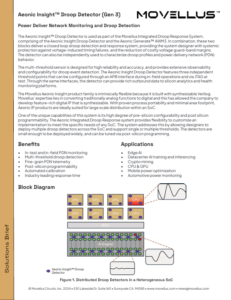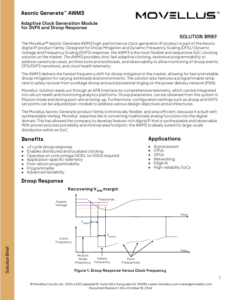MENU
CLOSE
Video
DAC IP Track - Droop! There it is!
Presented at DAC 2024 –
SoCs designed for compute-intensive workloads, such as AI training and inferencing, continue to grow and power budgets are increasing geometrically. Power consumption is comprised of dynamic and static power elements. The latter is generally fixed and determined by process technology and design techniques, while the former depends on workloads and frequency. This variability of workloads can drive rapid changes in current draw, which causes voltage droop, a rapid drop in power rails that can lead to timing glitches and system failures. For example, sudden changes in models or weights can drive these sudden shifts in workloads causing voltage droops.
Silicon design teams have attempted to address droop in various ways, but all methods have significant downsides. The typical options employed are increasing voltage margins, reducing operating frequencies, scheduling workloads through software, or using active droop mitigation methods that may be fully custom or tailored to their needs. Each of these solutions has advantages and drawbacks regarding power, performance, and implementation effort.
This discussion will explore the root causes of droop, its impact on power, and the increasing challenges in advanced nodes. It will also delve into modern droop mitigation techniques, highlighting the advantages of a tightly-coupled, synthesizable solution.
Related Content
Stay Connected
Stay Connected
By clicking “Accept”, you consent to the use of ALL the cookies. ACCEPTREJECT
Privacy Overview
| Cookie | Duration | Description |
|---|---|---|
| __hssrc | session | This cookie is set by Hubspot whenever it changes the session cookie. The __hssrc cookie set to 1 indicates that the user has restarted the browser, and if the cookie does not exist, it is assumed to be a new session. |
| cookielawinfo-checbox-analytics | 11 months | This cookie is set by GDPR Cookie Consent plugin. The cookie is used to store the user consent for the cookies in the category "Analytics". |
| cookielawinfo-checbox-functional | 11 months | The cookie is set by GDPR cookie consent to record the user consent for the cookies in the category "Functional". |
| cookielawinfo-checbox-others | 11 months | This cookie is set by GDPR Cookie Consent plugin. The cookie is used to store the user consent for the cookies in the category "Other. |
| cookielawinfo-checkbox-advertisement | 1 year | Set by the GDPR Cookie Consent plugin, this cookie is used to record the user consent for the cookies in the "Advertisement" category . |
| cookielawinfo-checkbox-necessary | 11 months | This cookie is set by GDPR Cookie Consent plugin. The cookies is used to store the user consent for the cookies in the category "Necessary". |
| cookielawinfo-checkbox-performance | 11 months | This cookie is set by GDPR Cookie Consent plugin. The cookie is used to store the user consent for the cookies in the category "Performance". |
| CookieLawInfoConsent | 1 year | Records the default button state of the corresponding category & the status of CCPA. It works only in coordination with the primary cookie. |
| JSESSIONID | session | The JSESSIONID cookie is used by New Relic to store a session identifier so that New Relic can monitor session counts for an application. |
| viewed_cookie_policy | 11 months | The cookie is set by the GDPR Cookie Consent plugin and is used to store whether or not user has consented to the use of cookies. It does not store any personal data. |
| Cookie | Duration | Description |
|---|---|---|
| __cf_bm | 30 minutes | This cookie, set by Cloudflare, is used to support Cloudflare Bot Management. |
| Cookie | Duration | Description |
|---|---|---|
| __hssc | session | HubSpot sets this cookie to keep track of sessions and to determine if HubSpot should increment the session number and timestamps in the __hstc cookie. |
| __hstc | session | This is the main cookie set by Hubspot, for tracking visitors. It contains the domain, initial timestamp (first visit), last timestamp (last visit), current timestamp (this visit), and session number (increments for each subsequent session). |
| _ga | 2 years | The _ga cookie, installed by Google Analytics, calculates visitor, session and campaign data and also keeps track of site usage for the site's analytics report. The cookie stores information anonymously and assigns a randomly generated number to recognize unique visitors. |
| _ga_F75FB76KBW | 2 years | This cookie is installed by Google Analytics. |
| _gat_gtag_UA_60322432_1 | 1 minute | Set by Google to distinguish users. |
| _gid | 1 day | Installed by Google Analytics, _gid cookie stores information on how visitors use a website, while also creating an analytics report of the website's performance. Some of the data that are collected include the number of visitors, their source, and the pages they visit anonymously. |
| hubspotutk | session | HubSpot sets this cookie to keep track of the visitors to the website. This cookie is passed to HubSpot on form submission and used when deduplicating contacts. |


